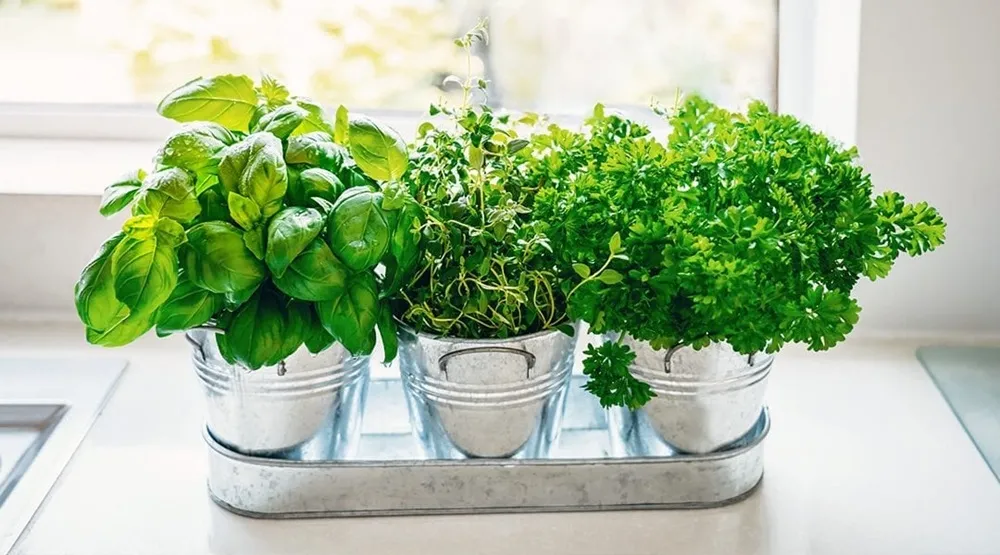How to Grow Your Own Herbs Indoors Year-Round

Developing your claim Herbs Indoors is a fulfilling and commonsense pastime that permits you to appreciate new, flavorful fixings all through the year. Herbs are flexible, simple to develop, and can be utilized in a wide assortment of dishes, from savory suppers to reviving teas. Whether you live in a little loft, a house with restricted open air space, or essentially need to have new herbs on hand at all times, developing Herbs Indoors is an arrangement that can advantage both your kitchen and your well-being. In this article, we’ll investigate how to develop Herbs Indoors year-round, the best herbs to develop, and fundamental tips for making the perfect indoor herb garden.
Choosing the Right Herbs for Indoor Growing
When it comes to developing Herbs Indoors, not all herbs are made rise to. A few herbs flourish in controlled indoor situations, whereas others may battle to develop without coordinated daylight and open air conditions. To guarantee victory in your indoor herb cultivation, it’s critical to select herbs that are well-suited to the indoor climate and that can prosper in containers.
Here are a few of the best herbs to develop indoors:
- Basil: Basil is one of the most well known herbs for cooking, and it develops well inside as long as it gets a bounty of light. It flourishes in warm temperatures and needs normal watering. You can develop basil in a little pot, close a sunny window or utilize a develop light to donate it the additional boost it needs amid the winter months.
- Mint: Mint is another incredible herb for indoor developing since it’s solid and generally low-maintenance. It develops rapidly and can be utilized in an assortment of dishes, from servings of mixed greens to pastries. Be that as it may, mint can become obtrusive, so it’s a great thought to plant it in its claim holder to anticipate it from taking over other plants.
- Parsley: Parsley is a nutritious herb that can be utilized in a wide run of dishes. It develops well inside and requires direct light. It’s too a tough herb, able to withstand cooler temperatures, which makes it perfect for developing inside amid the colder months.
- Thyme: Thyme is a fragrant herb that flourishes in dry conditions, making it ideal for indoor development. It favors a part of daylight and a well-draining pot, making it perfect for window sills with a bounty of coordinated light. Thyme moreover doesn’t require over the top water, so it’s moderately simple to care for indoors.
- Oregano: Oregano is a strong herb that develops well inside as long as it gets a bounty of daylight. It’s an incredible expansion to Italian, Greek, and Mediterranean dishes. Like thyme, oregano requires negligible watering and ought to be planted in a well-draining container.
- Chives: Chives are another easy-to-grow herb that flourishes inside. They incline toward cool temperatures and can handle direct daylight, making them perfect for a kitchen windowsill. Chives are idealized for including a mellow onion flavor to dishes, and their long, green stems make for an appealing indoor plant.
- Cilantro: Cilantro is a well known herb utilized in numerous cuisines, particularly Mexican and Indian dishes. Whereas it can be a bit precarious to develop inside due to its inclination to jolt in warm conditions, it can still flourish in cooler zones with satisfactory daylight. Cilantro develops rapidly and can be gathered in a few weeks.
Setting Up Your Indoor Herb Garden
Creating the idealized environment for your indoor herbs requires consideration to light, temperature, and mugginess. Since most herbs require a bounty of daylight to develop well, it’s critical to put your plants in regions that get adequate light. Here’s how you can set up your indoor herb garden:
- Choose the Right Area: Most herbs require at least 6 hours of coordinated daylight per day. A south-facing window is ordinarily the best spot for indoor herb gardens, as it will give the most light. If you don’t have a sunny window, you can supplement characteristic light with develop lights that give the fundamental range for solid plant growth.
- Use the Right Holders: Herbs require well-draining holders to maintain a strategic distance from root decay. Select pots with seepage gaps to guarantee water doesn’t amass at the foot. You can utilize conventional earthenware pots, plastic holders, or any other sort of pot that permits for great seepage. Make beyond any doubt the holder is expansive and sufficient to suit the herb’s root framework as it grows.
- Prepare the Soil: Herbs incline toward well-draining soil that is wealthy in supplements. Utilize a high-quality preparing blend that gives an adjustment of dampness maintenance and seepage. You can moreover include perlite or sand to the soil to progress waste and avoid water from pooling around the roots.
- Consider Temperature and Mugginess: Most herbs incline toward temperatures between 60°F and 70°F (15°C to 21°C). Dodge putting your herbs close to cold drafts or warming vents, as extraordinary temperature vacillations can stretch the plants. Moreover, indoor situations can some of the time be dry, particularly amid the winter months, so you may require to increment stickiness. You can put a little humidifier close to your herb plant or once in a while fog the plants to keep up the right level of humidity.
Caring for Your Indoor Herbs
Once your indoor herb plant is set up, it’s vital to give appropriate care to keep your plants solid and flourishing. Here are a few tips to guarantee your herbs develop well indoors:
- Watering: Indoor herbs ought to be watered frequently, but it’s critical not to overwater them. Most herbs incline toward soil that is somewhat dry between waterings, so check the soil dampness by staying your finger into the soil. If it feels dry to the touch, it’s time to water. Continuously guarantee that overabundant water can deplete absent from the pot to anticipate root rot.
- Fertilizing: Whereas herbs by and large don’t require a part of fertilizer, they will benefit from periodic nourishing. Utilize an adjusted, water-soluble fertilizer each 4-6 weeks amid the developing season. Dodge over-fertilizing, as this can lead to over the top leaf development at the cost of flavor.
- Pruning: Normal pruning is basic to energize solid development and anticipate herbs from getting to be leggy or congested. Trim back any dead or yellowing clears out, and routinely gather the takes off to energize unused development. For herbs like basil, squeezing back the developing tips can offer assistance to advance bushier plants.
- Pests and Illnesses: In spite of the fact that indoor herbs are less likely to endure from bothers than open air plants, they can still be defenseless to aphids, insect vermin, or whiteflies. Keep an eye out for any signs of bothers and treat them expeditiously utilizing characteristic cures, such as neem oil or insecticidal cleanser. Legitimate care, such as satisfactory watering and great discuss circulation, can too offer assistance to anticipate the advancement of diseases.
Harvesting and Utilizing Your Herbs
One of the most prominent rewards of developing your possess Herbs Indoors is the capacity to collect new takes off at whatever point you require them. Standard collecting energizes sound development and guarantees that your plants stay profitable. Here’s how to gather and utilize your herbs:
- How to Gather: When gathering herbs, it’s best to cut off takes off or stems with a match of sharp scissors or cultivate shears. For most herbs, it’s best to collect in the morning after the dew has dried but some time recently the warm of the day sets in. This guarantees that the oils in the clears out, which contribute to flavor and smell, are at their peak.
- Using New Herbs: New herbs can be utilized in a assortment of dishes, from savory suppers to reviving refreshments. Include new basil to pasta dishes, beat your servings of mixed greens with mint or parsley, or blend rosemary into broiled vegetables. You can too make home grown teas by soaking new takes off in hot water.
- Preserving Herbs: If you have an plenitude of herbs, you can protect them by drying or solidifying them for afterward utilize. To dry herbs, hang them upside down in a cool, dry area until the takes off are fresh. Once dried, store the herbs in sealed shut holders. Solidifying herbs is too an choice, especially for herbs like basil and oregano. Essentially chop them up, put them in ice 3d shape plate, and cover them with olive oil some time recently freezing.
Conclusion
Growing your claim Herbs Indoors year-round is a fulfilling and maintainable way to improve your cooking, move forward your wellbeing, and appreciate the excellence of plants in your domestic. By choosing the right herbs, setting up the appropriate environment, and giving the right care, you can effectively develop a flourishing indoor herb cultivate. Whether you’re a tenderfoot or an experienced cultivator, the fulfillment of developing your possess new herbs is unmatched. By taking after the tips laid out in this direct, you’ll be able to appreciate flavorful herbs all through the year, upgrading your suppers and making a more dynamic and maintainable living space.







